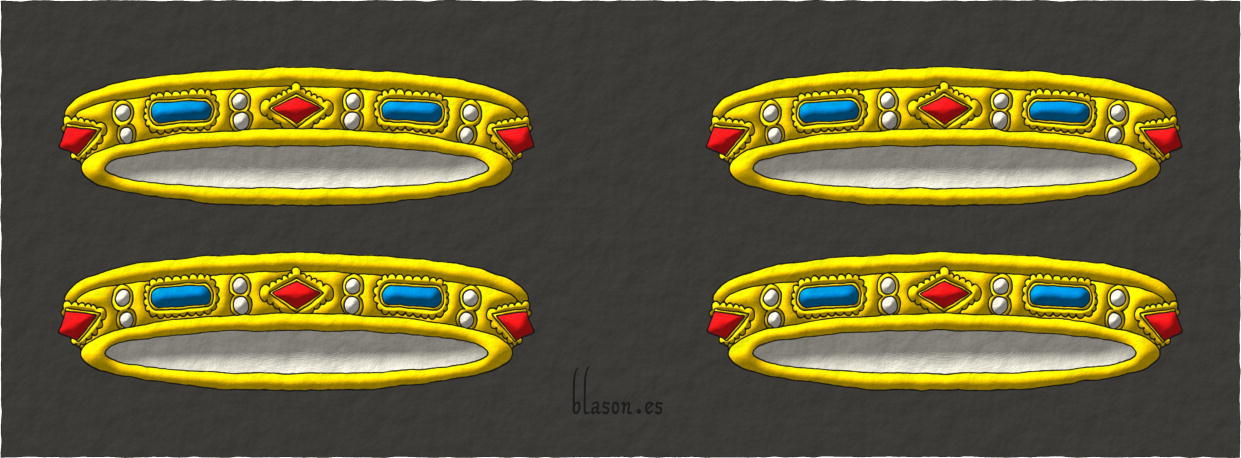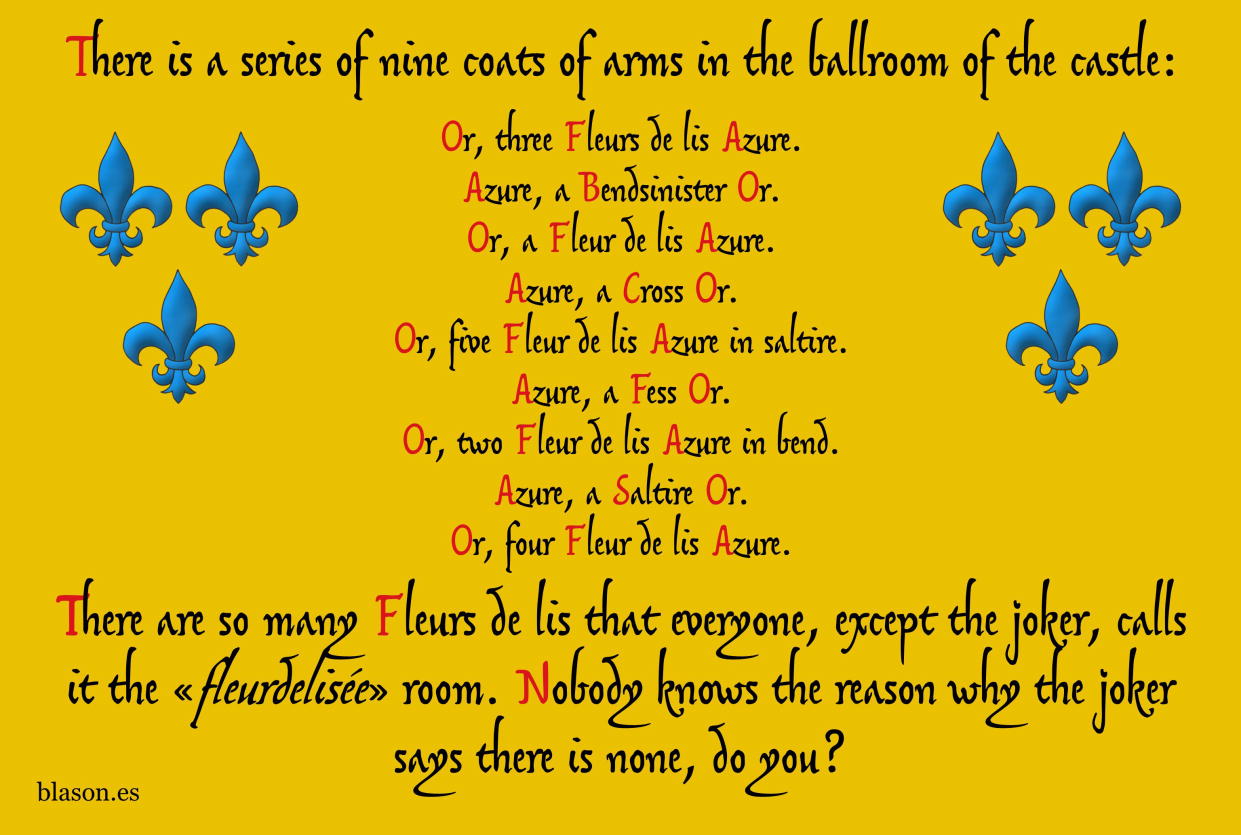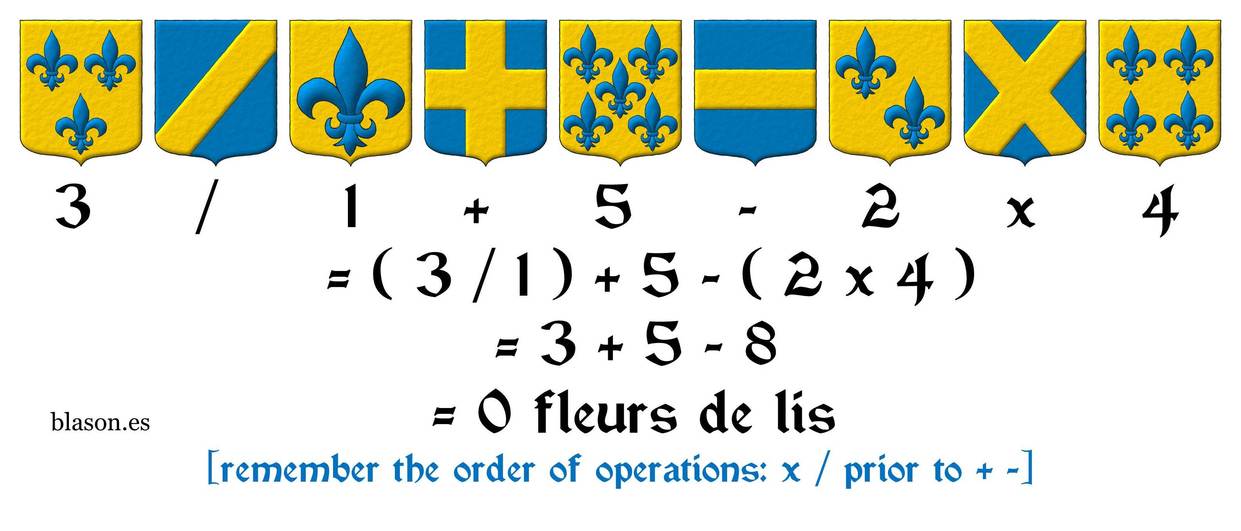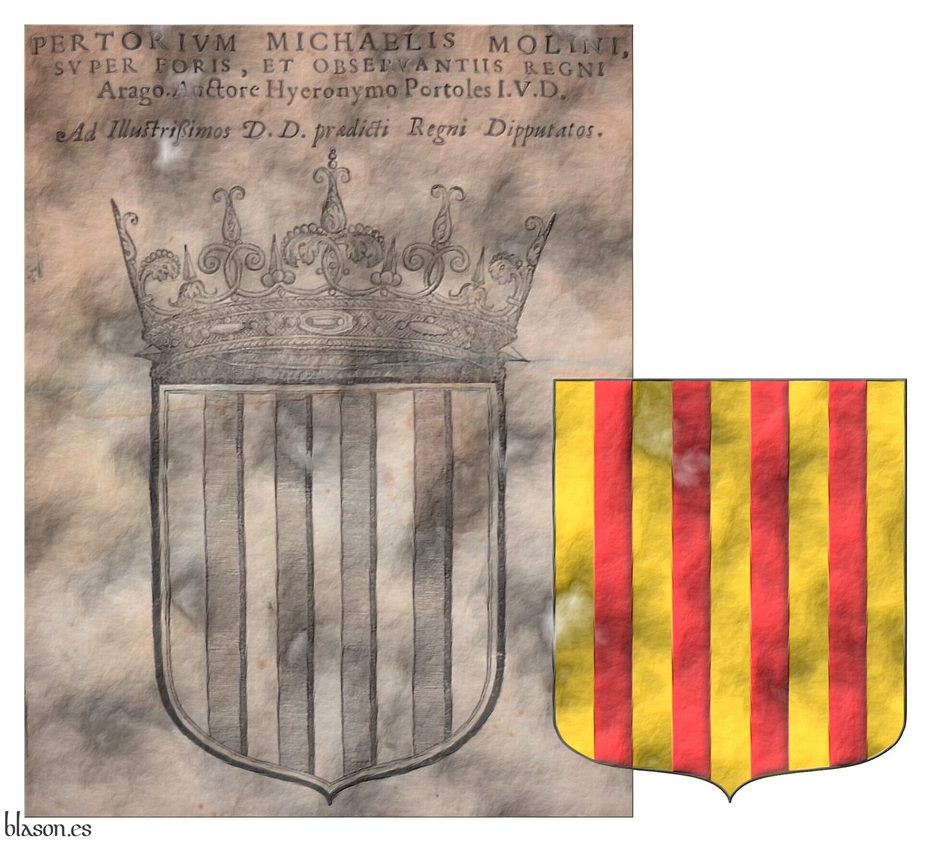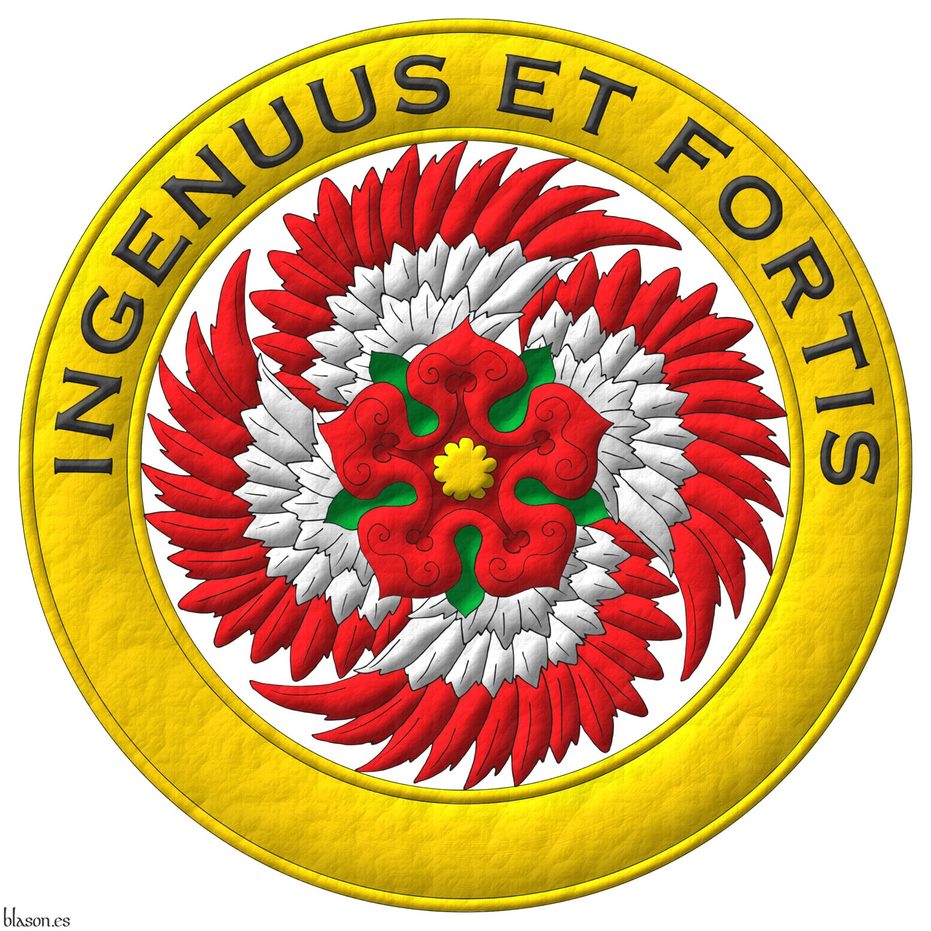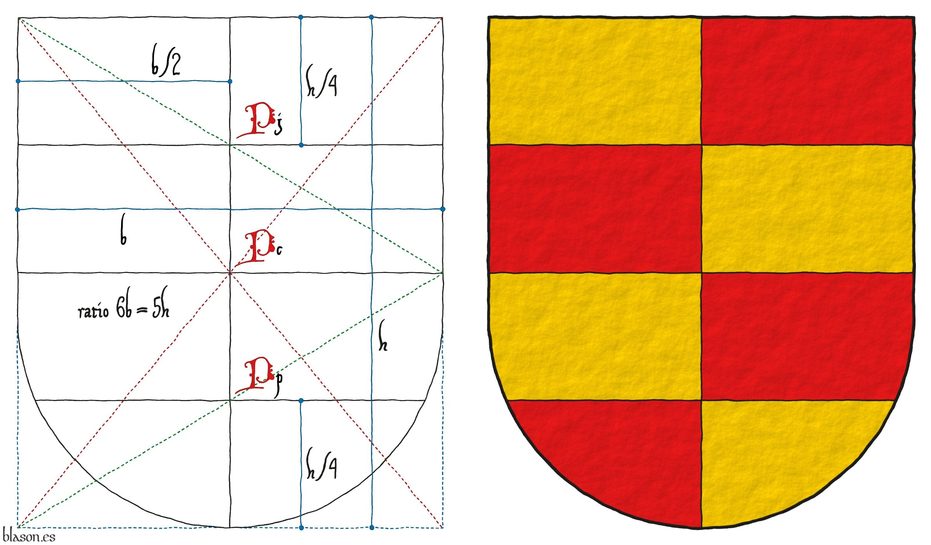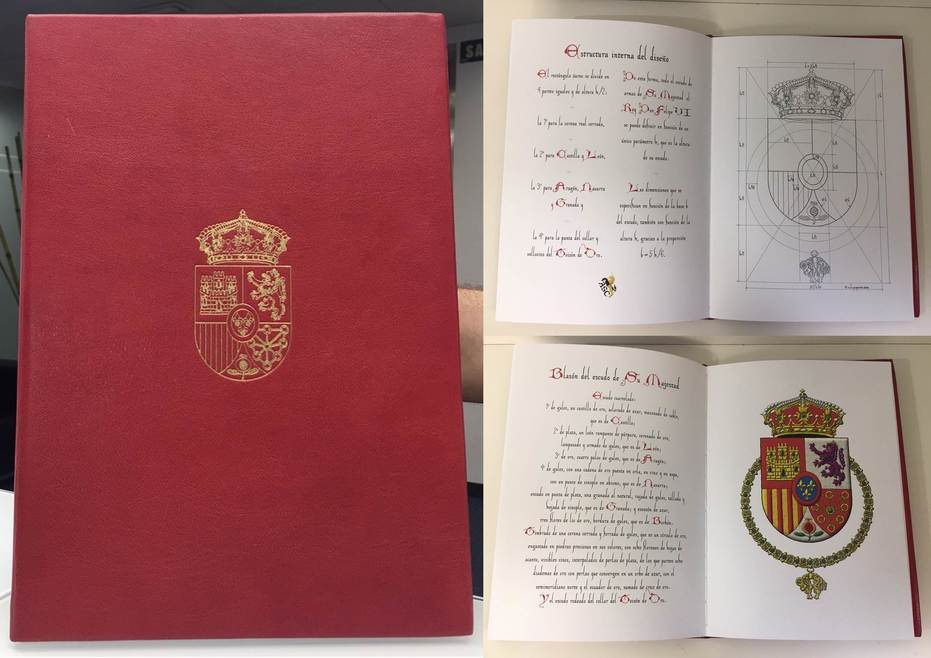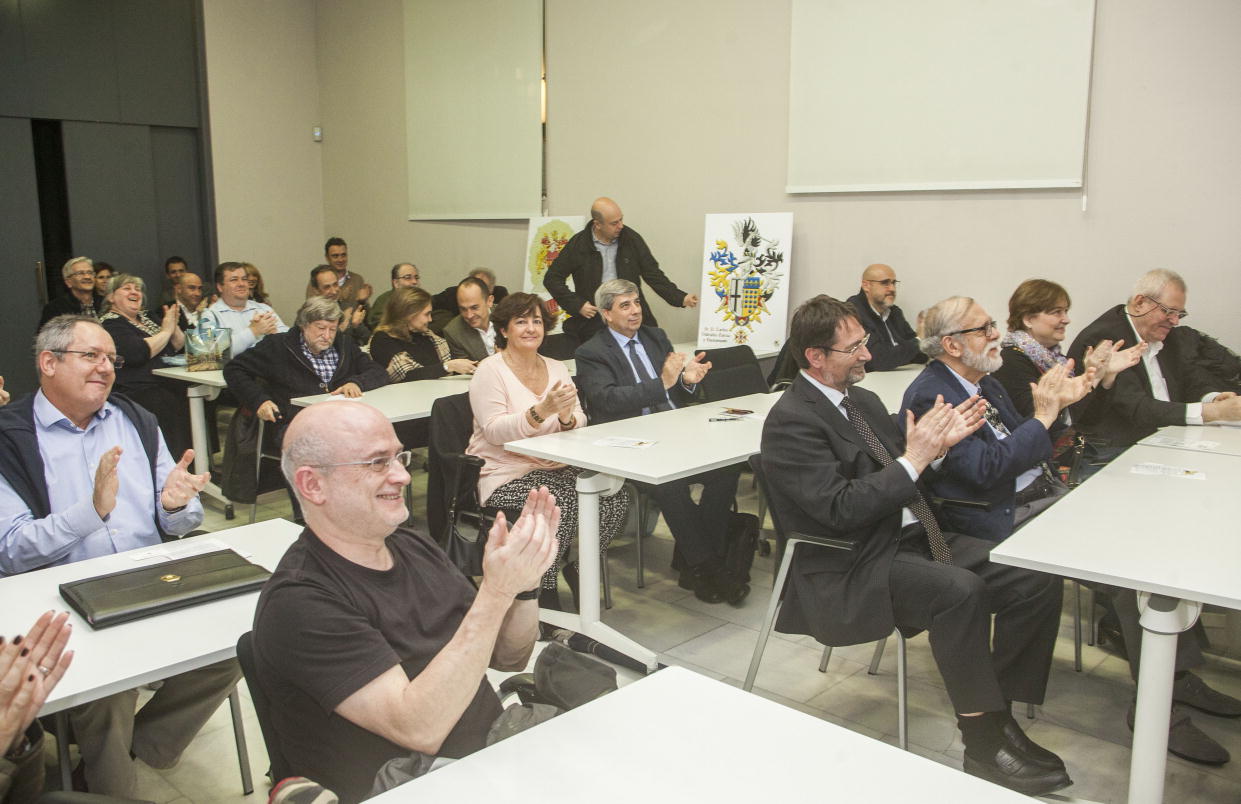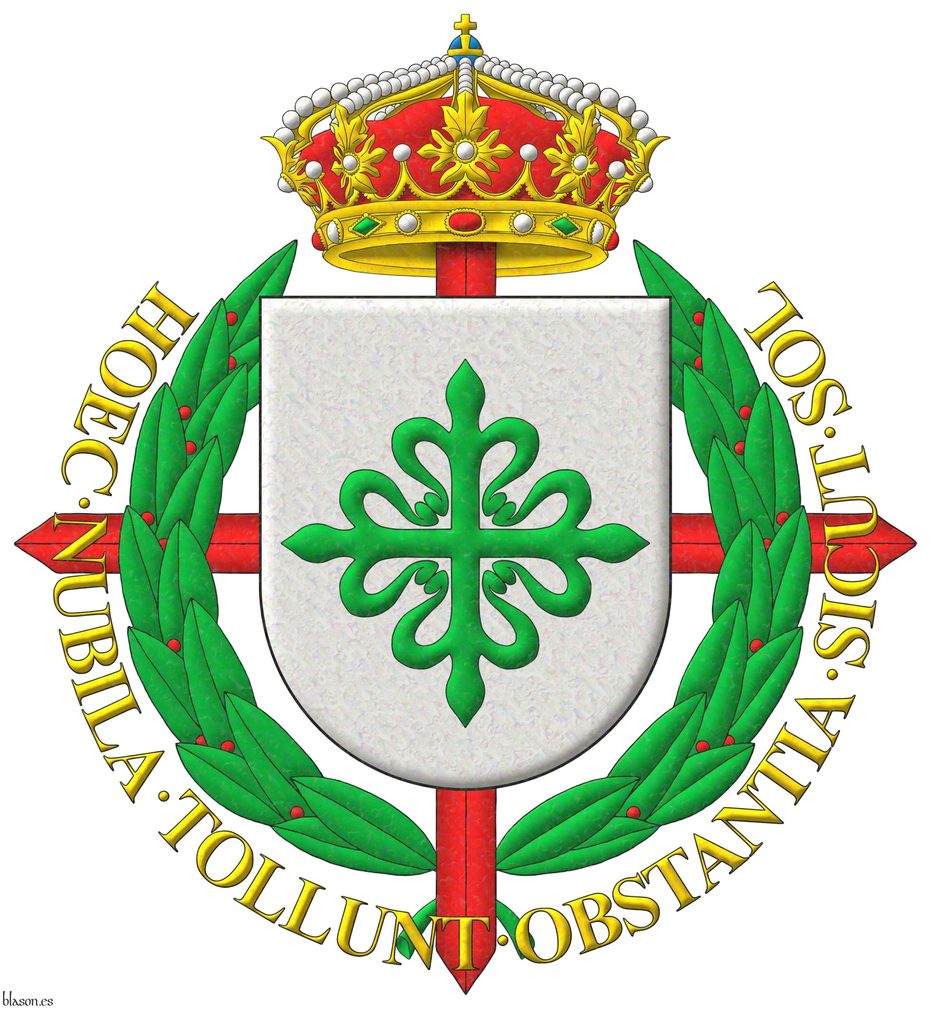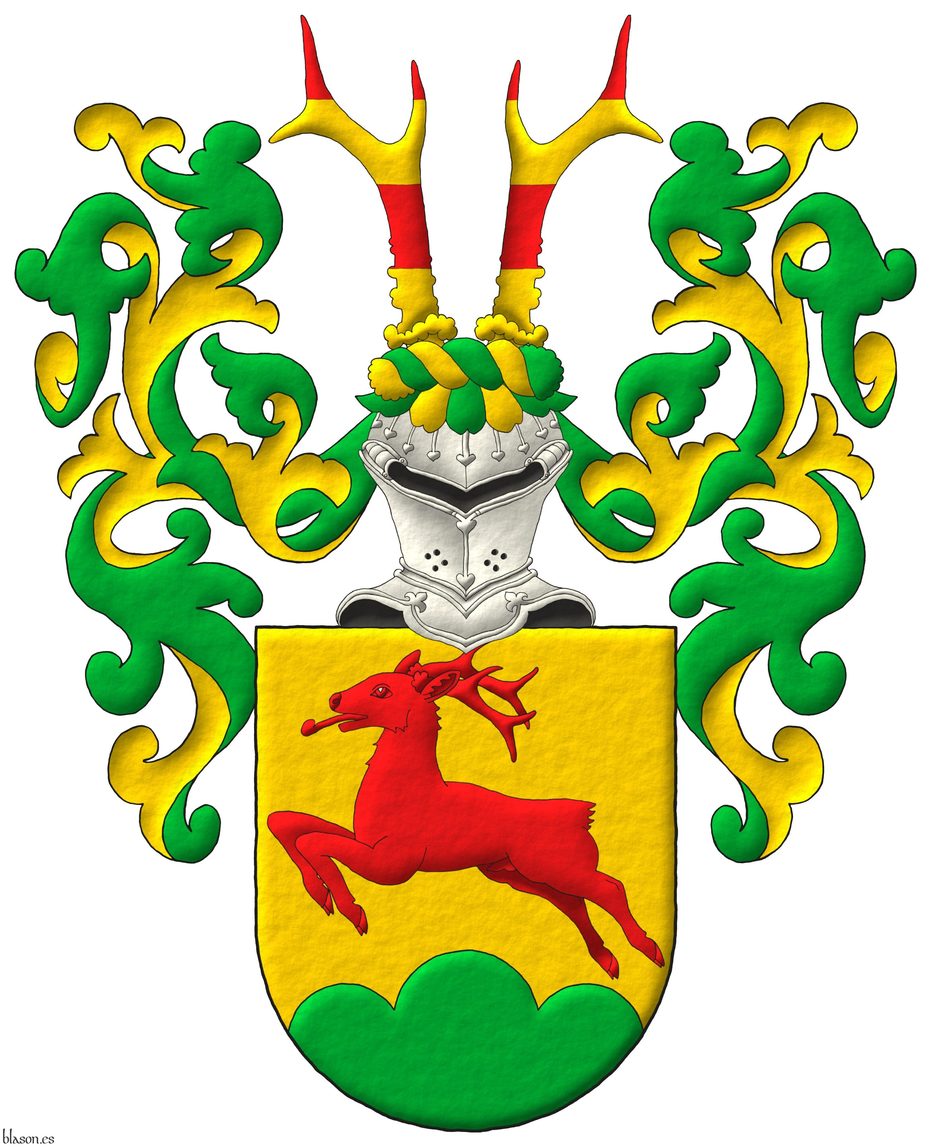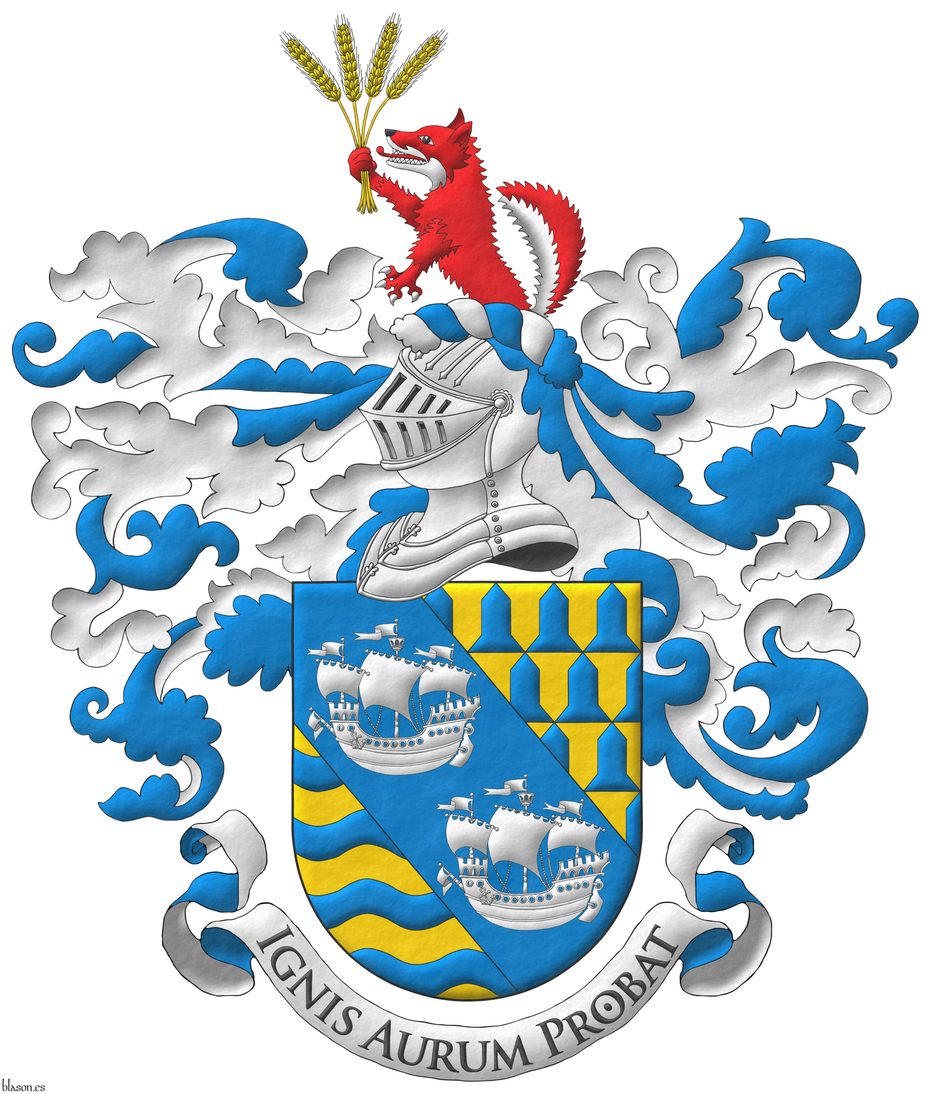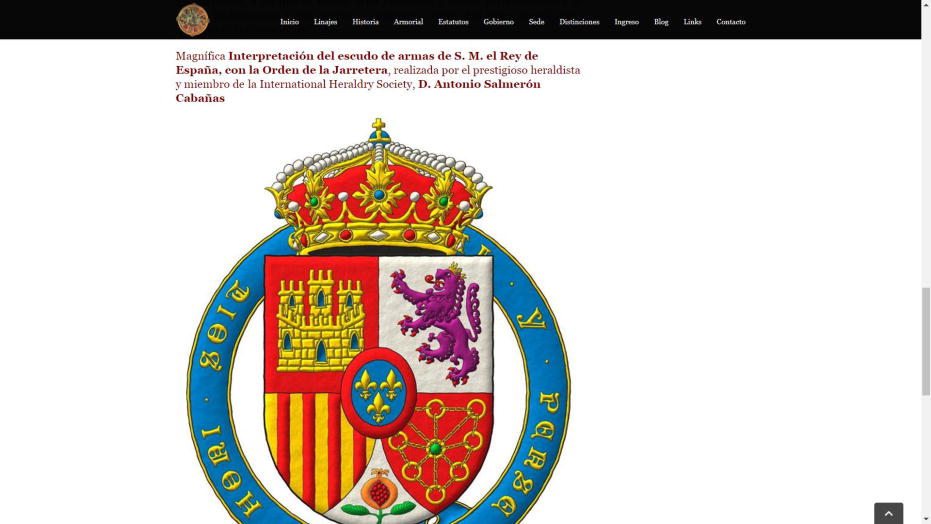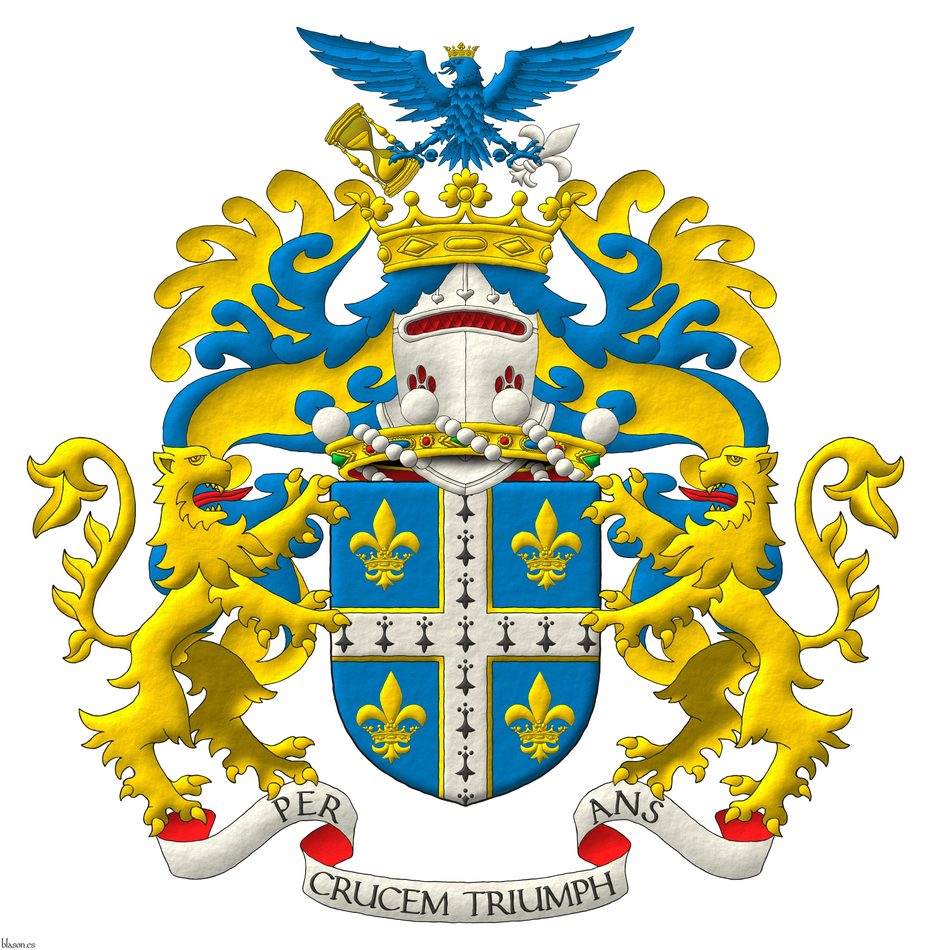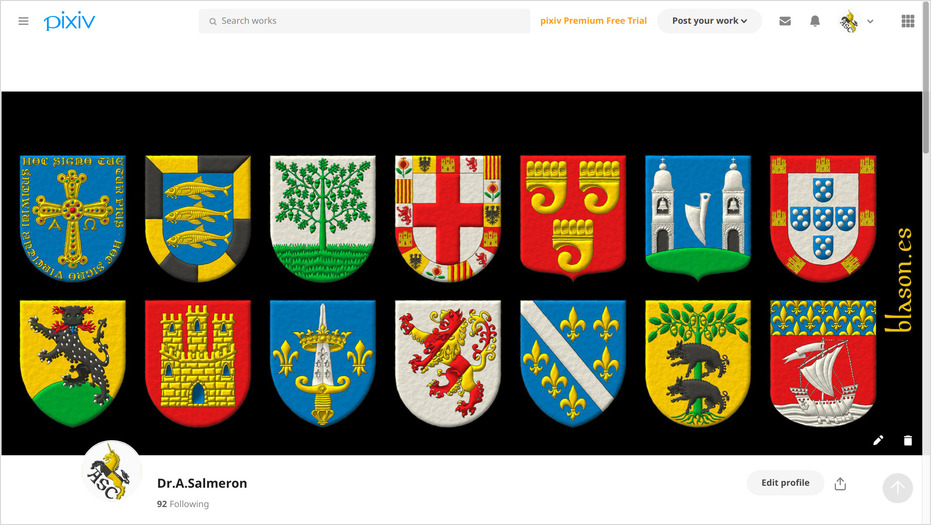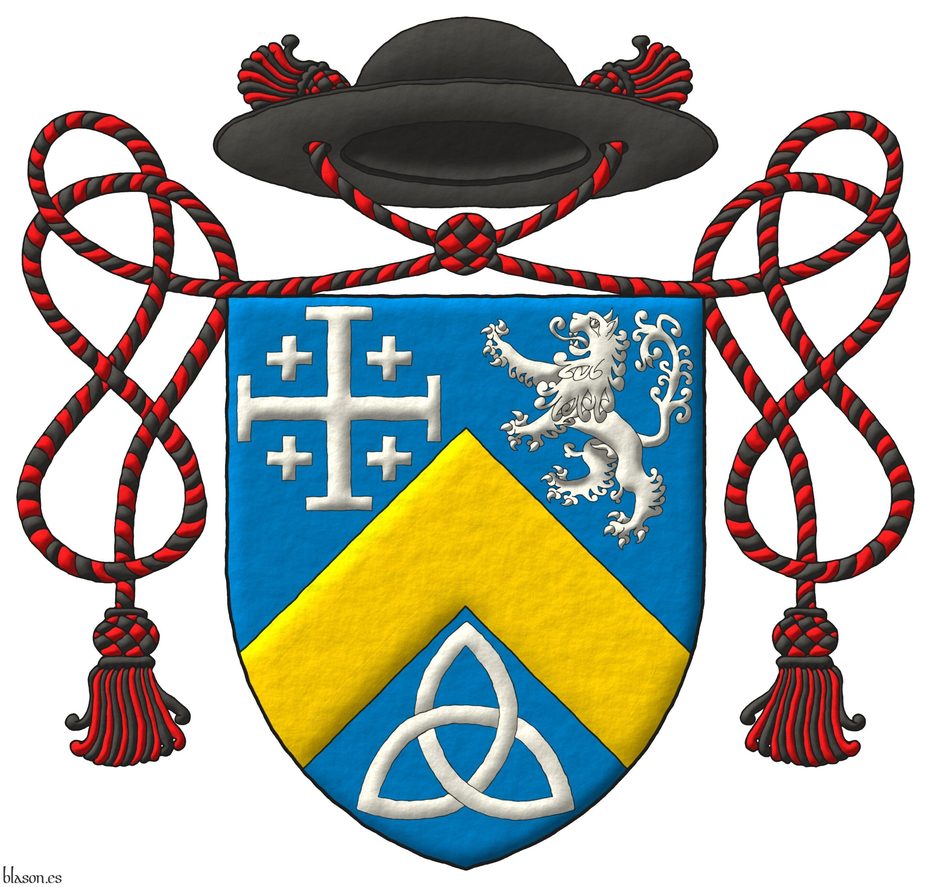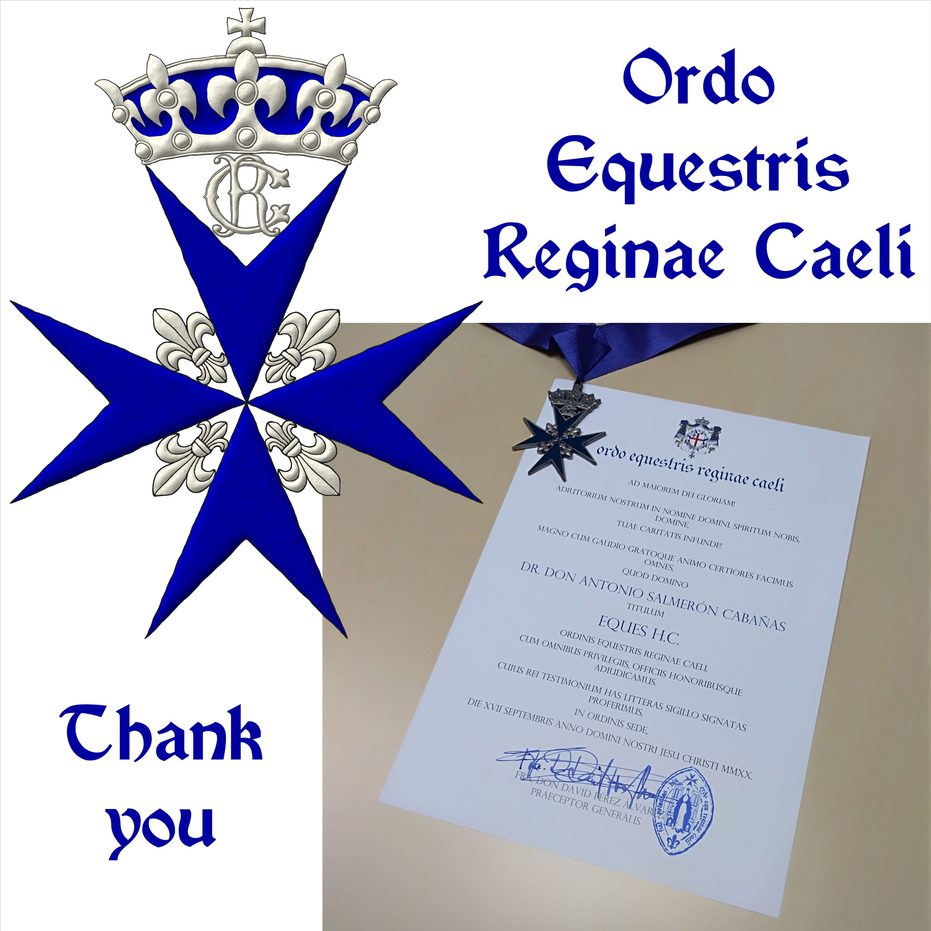Four


9 coats of arms in the ballroom
There is a series of nine coats of arms in the ballroom of the castle:
- Or, three Fleurs de lis Azure.
- Azure, a Bendsinister Or.
- Or, a Fleur de lis Azure.
- Azure, a Cross Or.
- Or, five Fleur de lis Azure in saltire.
- Azure, a Fess Or.
- Or, two Fleur de lis Azure in bend.
- Azure, a Saltire Or.
- Or, four Fleur de lis Azure.
There are so many Fleurs de lis that everyone, except the joker, calls it the «fleurdelisée» room. Nobody knows the reason why the joker says there is none, do you?
Think before you move the cursor or click on the following link and see the solution.
Categories: Riddle, Or, Azure, Fleur de lis, One, Two, Three, Four, Five, Bend sinister, Cross, Fess and Saltire.


9 coats of arms in the ballroom, solution
Categories: Riddle solution, Ogee, Outlined in sable, Freehand, Or, Azure, Fleur de lis, One, Two, Three, Four, Five, Bend sinister, Cross, Fess and Saltire.


Antonio José Gómez Morillo
Argent, a cross patty Gules charged with a double rose Argent and Gules, barbed Vert, seeded Or, between four double roses Gules and Argent, barbed Vert, and seeded Or.
Coats of arms emblazoned by me with a shapes ended with semi-circular arches, illuminated, and with a leather finishing.
Once his roses have been selected (their kind, number, and layout), I redesign the shape of the cross patty to adapt it to his roses, and I redistribute the surfaces of metal Argent and color Gules looking for a more equilibrate artwork. This evolution does not change the blazon.
Blazon keywords: Argent, One, Cross patty, Cross couped, Gules, Charged, Double rose, Barbed, Seeded, Between and Four.
Style keywords: Semi-circular, Outlined in sable, Illuminated and Leather.
Classification: Personal, Created and Coat of arms.
Bearer: Gómez Morillo, Antonio José.


Aragon
Or, four pallets Gules.
Escudo de oro, cuatro palos de gules.
Recreated coat of arms of Aragón in the following manner: the escutcheon shape is pointed and rounded; the field is rendered in flat Or; the pallets are illuminated; and the whole has a parchment-like finish.
This rendition of the coat of arms is based on [Portolés, J.; Molino, M. del; 1590].
Blazon keywords: Without divisions, Or, Four, Pale and Gules.
Style keywords: Ogee, Illuminated and Parchment.
Classification: Interpreted, Civic, Coat of arms and Kingdom of Aragon.
Bearer: Aragon.


Bertrand de Blanchefort two-step scheme
Barry of four per pale counterchanged Or and Gules.
Blazon keywords: Barry per pale counterchanged, Four, Or and Gules.
Style keywords: Outlined in sable, Semi-circular, Ratio and Plain tincture.
Classification: Religious, Military, Knights Templar, Interpreted, Coat of arms and Schema.
Bearer: Blanchefort, Bertrand de.


Book on the arms of Felipe VI of Spain designed using the golden ratio
Nine of my interpretations of the coat of arms of His Majesty King Felipe VI of Spain, together with three constructive diagrams illustrating my execution of this coat of arms, were documented, edited, and printed in book form. Two unique copies were hand-bound in leather, with the cover engraved with this coat of arms. One of them was delivered to the Household of His Majesty, and I received a letter conveying His Majesty the King’s gratitude for my heraldic interpretation of his coat of arms based on the golden ratio.
Blazon keywords: Gules, Azure, Purpure, Vert, Or, Argent, One, Three, Four, Quarterly, Castle, Triple-towered, Port and windows, Masoned, Lion, Rampant, Crowned, Pallet, Chain, Orlewise, Crosswise, Saltirewise, Charged, In the fess point, Emerald, Enté en point, Pomegranate, Proper, Slipped, Leaved, Inescutcheon, Fleur de lis, Ordered, Bordure, Closed royal crown, Crown, Surrounded and Collar.
Style keywords: Ratio, Outlined, Outlined in sable, Illuminated and Semi-circular.
Classification: Personal, Kingdom of Spain, De bibliotheca, In color, Castilian language, Interpreted, Schema, Boa, Collage and Photographic.
Bearer: Felipe VI of Spain.


Carlos Vidriales, his arms in my Lecture at the International Lab
Credits: Pablo Plaza is the author of the photograph and Antonio Salmerón y Cabañas is the author of the heraldic art of the coats of arms photographed.
Categories: Photographic, Coat of arms, Interpreted, Personal, Semi-circular, Illuminated, Outlined in sable, Party per pale, Argent, Cross, Sable, Bordure, Motto, Or, Thirteen, Hurt, Hurt, torteau, pellet, pomme and golpe, Azure, Three, In pale, Four, Five, Chief, Fleur de lis, Lineage, Conjoined in fess, Decoration, Suspended and Base (lower 1/3).
Root: Vidriales García y Bustamante, Carlos.


Cavalry Regiment Alcantara, Laureate of Saint Ferdinand
Grand Laureate Cross of Saint Ferdinand.
Argent, a cross of Alcantara. Crest: A closed royal crown Or, with eight arches, visible five. Behind the shield the Laureate Grand Cross of Saint Ferdinand. Motto: «Hoec nubila tollunt obstantia sicut sol».
Escudo de plata, una cruz de Alcántara. Timbrado de una corona real cerrada. Acolada detrás del escudo la gran cruz laureada de San Fernando. Lema: «Hoec nubila tollunt obstantia sicut sol».
Coat of arms interpreted in the following manner: the shape of the shield is of a semicircular arch; the field is illuminated in metal Argent; the cross of Alcantara, the 4 swords and the 2 laurel branches are outlined in Sable and illuminated in Vert and Gules; the royal crown is closed, outlined in Sable and illuminated with the metal Or, Argent for the pearls, Azure and Or for the orb, Gules and Vert for the gems, Gules for the inner cloth, and Sable for the visible hollow at its base; and the whole has a iridescent finish.
Rif War, July 23, 1921, banks of the Igan River, North Africa
The Alcantara Regiment executed nine successive cavalry charges to protect the infantry's retreat, nine charges until they broke the enemy lines, outnumbering them. The last charge was on foot because all their horses were dead or exhausted. These heroic riders of Alcantara had fulfilled their duty of protecting the wounded infantry in their retreat to El Batel, but the price was appalling: of 691 riders, only 67 survived, and three months were necessary to recover hundreds of corpses.
For this reason, in 2012, the Alcántara Regiment was collectively awarded the Grand Laureate Cross of Saint Ferdinand.
Two lances behind the shield
Since 1987, the coat of arms of the cavalry regiments of the Spanish Army must carry two crossed lances accolade behind the shield. And indeed, this coat of arms of the Alcántara Cavalry Regiment has two lances behind the shield, but in my artistic heraldic interpretation, I did not paint them to avoid detracting from the prominence of the Laureate Cross.
Blazon keywords: Without divisions, Argent, Cross of Alcantara, Cross couped, Cross, Crest, Closed royal crown, Crown, Behind the shield, Four, Sword, Crosswise, Gules, Two, Branch, Laurel, Vert and Motto.
Style keywords: Semi-circular, Illuminated, Outlined in sable and Iridescent.
Classification: Interpreted, Military, Army and Navy and Coat of arms.
Bearer: Alcantara, Cavalry Regiment.


City of Almeria, structured and parallel blazons
Coat of arms of the city of Almeria, Andalusia, emblazoned by me, with the blazon written in English and Castilian in a structured way to observe the parallelism between both forms. Starting from the section at the dexter chief as number 1, I number the sections of the bordure clockwise. In this particular case, as in others where the number of different charges is an exact divisor of the total number of sections, the numbering coincides even if counted counterclockwise.
Blazon keywords: Argent, Gules, Or, Sable, Vert, One, Four, Fifteen, Cross, Bordure, Compony, Pomegranate, Slipped, Leaved, Proper, Eagle, Castle, Triple-towered, Port and windows, Masoned, Lion, Rampant, Crowned, Pallet, Closed royal crown, Crown, Motto and Scroll.
Style keywords: Outlined in sable, Illuminated, Semi-circular and Parchment.
Classification: Civic, Interpreted, Structured and parallel blazons, Boa and Coat of arms.
Bearer: Almeria, city of.


Crest of Alena Rehberger
Or, a roe deer springing Gules, in base a triple mount Vert. Crest: Upon a helm affronty, with a wreath Or and Vert, two roe deers' attires barry of four Gules and Or. Mantling: Vert doubled Or..
Credits:
- Stephan Urs Breu is the designer of the coat of arms.
- Antonio Salmerón y Cabañas is the author of the heraldic art.
Blazon keywords: Or, One, Roe deer, Springing, Gules, In base, Trimount, Vert, Crest and mantling, Helm, Mantling, Wreath, Crest, Two, Roe deers' attires, Barry and Four.
Style keywords: Outlined in sable, Semi-circular, Illuminated and Freehand.
Classification: Personal, Interpreted and Coat of arms.
Bearer: Rehberger, Alena.


Crest, mantling and motto of the Milian family Milian
Tierced per bend: 1 vairy Or and Azure; 2 Azure, two ships in full sail, in bend Argent; 3 Or, four bars wavy Azure. Crest: Upon a helm, with a wreath Argent and Azure, a demi-red fox proper, grasping dexter four wheat spikes Or. Mantling: Azure doubled Argent. Motto: «Ignis Aurum Probat».
Arms devised by me, highlighted with lights and shadows, contoured in Sable, with a semi-circular outer contour and with a rough finish.
Blazon keywords: Or, Azure, Argent, One, Two, Four, Crest, Tierced per bend, Vairy, Ship, Full sail, Bend, Bar, Wavy, Crest and mantling, Upon (wreath), Helm, Wreath, Demi, Fox, Rampant, Proper, Grasping, Dexter, Wheat spike, Wheat, Mantling and Motto.
Style keywords: Outlined in sable, Illuminated, Semi-circular and Rough.
Classification: Personal, Created, Boa and Coat of arms.
Bearer: Milian, family.


Crown of Her Royal Highness Doña Leonor Princess of Asturias
![Crown of Her Royal Highness Doña Leonor Princess of Asturias Quarterly: 1 Gules, a castle triple-towered Or, port and windows Azure, masoned Sable [for Castile]; 2 Argent, a lion rampant Purpure, armed and langued Gules, crowned Or [for Leon]; 3 Or, four pallets Gules [for Aragon]; 4 Gules, a chain orlewise, crosswise, and saltirewise Or, charged in the fess point with an emerald Vert [for Navarre]; enté en point Argent, a pomegranate proper, seeded Gules, slipped and leaved Vert [for Granada]; an inescutcheon Azure, three fleurs de lis Or, 2 and 1, a bordure Gules [for Bourbon]; and the whole debruised by a label of three points Azure. Crest: A Crown of Prince. The shield is surrounded by the Golden Fleece.](../escudo_armas/LeonorPA.27.Corona.Preciosas.Toison.Irisado.jpg)
Quarterly: 1 Gules, a castle triple-towered Or, port and windows Azure, masoned Sable [for Castile]; 2 Argent, a lion rampant Purpure, armed and langued Gules, crowned Or [for Leon]; 3 Or, four pallets Gules [for Aragon]; 4 Gules, a chain orlewise, crosswise, and saltirewise Or, charged in the fess point with an emerald Vert [for Navarre]; enté en point Argent, a pomegranate proper, seeded Gules, slipped and leaved Vert [for Granada]; an inescutcheon Azure, three fleurs de lis Or, 2 and 1, a bordure Gules [for Bourbon]; and the whole debruised by a label of three points Azure. Crest: A Crown of Prince. The shield is surrounded by the Golden Fleece.
Arms depicted by me, highlighted with lights and shadows, outlined in Sable, with a semi-circular external shape and with a iridescent finish.
This is my interpretation of the coat of arms of Her Royal Highness Doña Leonor Princess of Asturias (as heiress to the Crown of Castile), Princess of Girona (as heiress to the Crown of Aragon), and Princess of Viana (as heiress to the Kingdom of Navarre), with the Collar of the Distinguished Order of the Golden Fleece. Her coat of arms is that of her father, the King, charged with a label Azure and surmounted by the crown of a princess with four pearl diadems, three visible.
Blazon keywords: Gules, Azure, Purpure, Vert, Or, Argent, One, Three, Four, Quarterly, Castle, Triple-towered, Port and windows, Masoned, Lion, Rampant, Crowned, Pallet, Chain, Orlewise, Crosswise, Saltirewise, Charged, In the fess point, Emerald, Enté en point, Pomegranate, Proper, Slipped, Leaved, Inescutcheon, Fleur de lis, Ordered, Bordure, Cadency, Label of three points, Crown of Prince, Crown, Surrounded and Collar.
Style keywords: Outlined in sable, Illuminated, Semi-circular and Iridescent.
Classification: Personal, Kingdom of Spain, Interpreted, Boa and Coat of arms.
Bearer: Leonor Princess of Asturias.


Daniel García Martínez

Sable, upon three bars wavy a four arch bridge Or, masoned Sable, throughout. Motto: «Patiens Quia Aeternus».
Escudo de sable, un puente de cuatro ojos de oro, mazonado de sable, moviente de los flancos, sostenido por tres burelas ondadas de oro. Lema: «Patiens Quia Aeternus».
Coat of arms devised by me, illuminated with lights and shadows, outlined in Sable, with a pointed external shape and with a rough finishing.
Design rationale
The symbols represent resilience over time, a bridge over the passage of waters. The design is simple and conceptual, a coat of arms without lines of divisions, and with only two tinctures, the color Sable of the field and the metal Or of the bridge and the waves of water. The motto «Patiens quia aeternus» ~ «Patient because eternal» comes from Augustine of Hippo and reinforces the meaning of this coat of arms.
Blazon keywords: Sable, Or, Three, Four, Upon, Wavy, Bar, Arch, Bridge, Masoned, Throughout and Motto.
Style keywords: Outlined in sable, Illuminated, Pointed and Rough.
Classification: Personal, Created, Design rationale, Boa and Coat of arms.
Bearer: García Martínez, Daniel.


Design with a fess between 4 water-bougets
Design ideas
The heraldic art often involves resolving design challenges while maintaining both aesthetic balance and adherence to tradition. The coat of arms illustrated here draws inspiration from the Dethick-Dethicke family arms of Derbyshire, though it features distinct differences. This design explores the placement of water-bougets, a medieval water vessel, in a 2+2 arrangement, with a fess vair.
One key consideration when arranging charges in heraldry is proportionality. In this case, the fess occupies 1/3 of the coat of arms's width and is positioned 1/3 of the height from the chief, rather than at the exact center, allowing the charges to balance harmoniously. The shape of the shield itself also plays a role: rounded shields can accommodate a 2+2 arrangement more comfortably than shields with a pointed base, which are better suited to 2+1 arrangements, this is de case of Dethick's arms.
Another challenge in heraldic design is asymmetry. To address the natural curves of the shield, the water-bougets may vary slightly in size or placement. This intentional asymmetry can help create a visually appealing composition that respects both tradition and the unique constraints of each design, because, heraldry is not only about rules but also about creativity.
Gules, a fess vair between four water-bougets Or, two in chief and two in base.
Escudo de gules, una faja de veros acompañada de cuatro pares de odres de oro, dos en jefe y dos en punta.
Water-bouget
In German, they are called «Wasserschlauch» in English «water-bougets» or «oges», and in French «bouses» or «chantepleures».
There is no specific heraldic term for them in Castilian. Based on «chantepleures», one could use «cantimploras», which are metallic or at least rigid. On the other hand, «oges» could translate as «odres», as they are typically made of leather as in this case. Additionally, since «water-bouget» are designed as a pair to be carried by a donkey or other animal, I have decided to use «par de odres» to convey the idea of one on each side of the animal.
In English, when there is a single charge, that is, a pair of water vessels, it is written in singular as «water-bouget», as can be seen in [Fox-Davies, A. C.; 1909; figure 551]. [Friar, S.; 1987; page 68] defines «bouget» as «...a stylized representation of a yoke supporting two leather waterbags».
Blazon keywords: Gules, One, Fess, Vair, Between, Four, Water-bouget, Or, Two, In chief and In base.
Style keywords: Ratio, Outlined, Outlined in sable, Illuminated, Semi-circular and Freehand.
Classification: Interpreted, Schema and Coat of arms.


Espeja Avieda, Alejandra
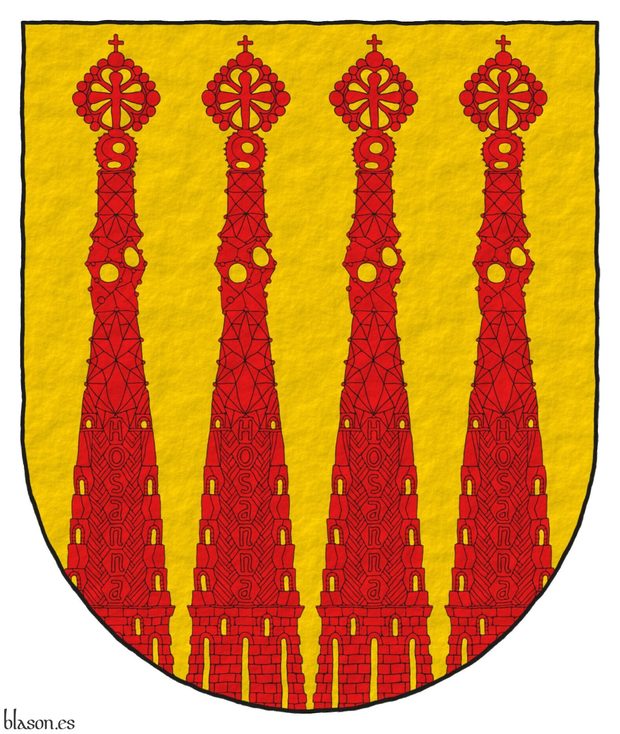
Or, four bell towers issuant from base Gules, windows Or.
Escudo de oro, cuatro campanarios movientes de la punta de gules, aclarados de oro.
Arms painted by me, in plain tinctures, outlined in Sable, with a semi-circular external shape and with a texturized finish.
Coat of arms of Alejandra Espeja Avieda designed by Juan Lanzagorta Vallín and emblazoned by me. Blazoning specific, real-world objects in coats of arms should be avoided. Therefore, in the blazon I describe «four bell towers». However, in this case, for artistic reasons, to echo the elongated form of the four pallets Gules, and due to the origin of the bearer, I depict four bell towers inspired by those on the Nativity Façade of Gaudí’s Sagrada Família in Barcelona. Additionally, I initially blazoned the arrangement of the 4 bell towers as «in fess» ~ «en faja», as, from a heraldic perspective, this term accurately describes their horizontal alignment next to each other across the field. However, I observed that this term, far from clarifying the design, caused confusion among some viewers. The naturally vertical shape of a bell tower, its default position, is «palewise» ~ «puesta en palo», so using «in fess» ~ «en faja» led many to assume that I intended to lay the bell towers on their sides. Although the original description was heraldically correct, I decided to remove the mention of «in fess» ~ «en faja» for being unnecessary and clearly counterproductive. As the towers are «issuant from base» ~ «movientes de la punta», their placement in a horizontal row is sufficiently implied, thus avoiding misunderstandings and maintaining the clarity of the blazon. It is important to remember that «in fess» ~ «en faja» refers to how multiple elements are aligned with each other (in a horizontal row), while «palewise» ~ «puesto en palo» describes the individual orientation of an element (in a vertical position).
Blazon keywords: Or, Gules, Four, Bell tower, Issuant from base and Port and windows.
Style keywords: Outlined in sable, Plain tincture and Semi-circular.
Classification: Personal, Interpreted, Boa and Coat of arms.
Bearer: Espeja Avieda, Alejandra.


![Ver [Felipe VI and the Order of the Garter in Twelve Lineages] en enlaces recomendados. Áncora de oro y la divisa enlace.](../css/Ancora.Enlace.png)
Felipe VI and the Order of the Garter in Twelve Lineages
Publication of my interpretation of the arms of His Majesty King Felipe VI with the Order of the Garter on the blog Twelve Lineages of Soria with the following text: Magnificent interpretation of the coat of arms of H.M. the King of Spain, with the Order of the Garter, made by the prestigious heraldist and member of the International Heraldry Society, Mr. Antonio Salmerón Cabañas.
Categories: Link, Or, Four, Pale, Gules, Azure, Sable, One, Castle, Port and windows, Masoned, Argent, Purpure, Lion, Rampant, Armed, Langued, Crowned, Chain, Orlewise, Crosswise, Saltirewise, Charged, In the fess point, Emerald, Vert, Closed royal crown, Crown, Inescutcheon, Fleur de lis, Bordure, Enté, In base, Pomegranate, Proper, Seeded (pomegranate), Slipped and Leaved.
Root: Twelve Lineages of Soria.


Francisca Aras Quirce
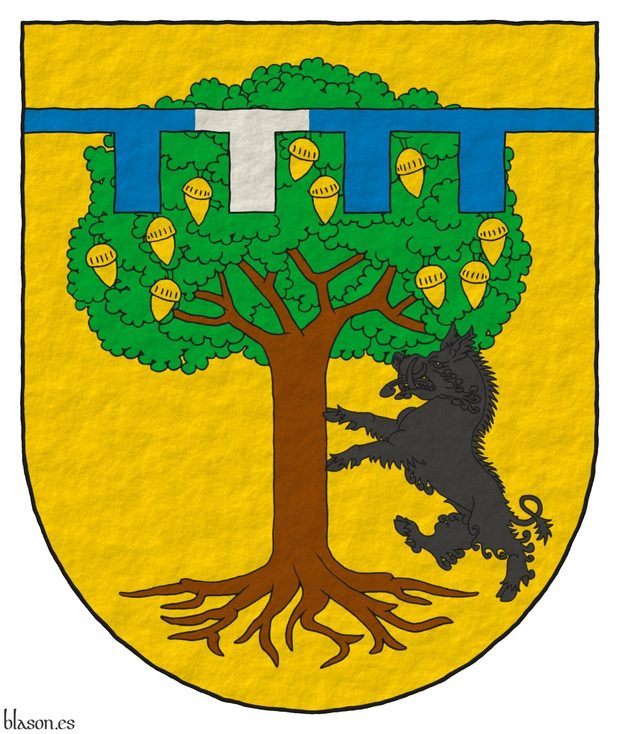
Or, an oak tree proper, fructed Or, with a boar supporting it Sable; the whole debruised by a label of four points Azure with the second point Argent.
Escudo de oro, un roble al natural, frutado de oro, con un jabalí empinado de sable; brisado de un lambel de cuatro pendientes de azur, el segundo pendiente de plata.
Coat of arms interpreted by me, in flat tinctures, outlined in Sable, with a semi-circular outer contour and with a texturized finish.
Coat of arms of Francisca Aras Quirce designed by Juan Lanzagorta Vallin and emblazoned by me.
Credits: Juan Lanzagorta Vallin is the designer of the coat of arms.
Blazon keywords: Or, One, Oak, Tree, Proper, Fructed, Boar, Supporting, Sable, Cadency, Label, Four, Azure and Argent.
Style keywords: Outlined in sable, Plain tincture and Semi-circular.
Classification: Personal, Interpreted and Coat of arms.
Bearer: Francisca Aras Quirce.


Full achievement of Andrew Ronald McMillan Bell of Auchinreoch
Gules, a cross Argent charged with four ermine spots in cross Sable, in the dexter of the chief a lion’s head erased Or. Crest: Upon a helm befitting his degree issuant from a crown of Baron above the shield, with a chapeau Gules turned up ermine, a demi-lion, double queued Or, grasping in its dexter paw a pennon Gules, bearing a canton Azure, charged with a saltire Argent. Mantling: Gules doubled Argent. War cry above the crest: «ΑΛΑΛΑ ΑΛΑΛΑ». Motto: «Mieux vaut s’user que rouiller». Supporters: Two knights in three-quarter armour affronty proper, each holding with his outer hand a spear Argent bearing a banner, the dexter Sable, a panther rampant guardant Argent, incensed Or, collared, pendent therefrom a bell Azure, the sinister a banner barry of six Or and Azure, a canton Ermine, terraced Vert semé of Maltese Rock Centaury (Cheirolophus crassifolius) slipped proper.
Arms interpreted by me, illuminated with lights and shadows, contoured in Sable, with a pointed outer contour and with a freehand finish.
G0116, Chief Herald of Arms of Malta's grant for the arms of Andrew Ronald McMillan Bell of Auchinreoch, United Kingdom. These arms have been emblazoned by me for such grant. The English term «terraced», sometimes used in blazon, is equivalent to the term «compartment». In Castilian blazon we use the term «terrazado», in this case as an element outside the shield, while «terrazado» also exists inside the shield in base.
Blazon keywords: Gules, Argent, Sable, Or, Azure, Vert, One, Four, Six, Cross, Charged, Ermine, In cross, Dexter, Chief, Lion, Head, Erased, Crest, Upon (wreath), Helm, Issuant, Crown of Baron, Crown, Above the shield, Chapeau, Demi, Double queued, Grasping, Canton, Saltire, War cry, Above the crest, Motto, Supporter (human form), Supporter, Knight, Affronty, Proper, Spear, Panther, Rampant, Guardant, Enflamed, Collar, Suspended, Bell, Barry, Compartment, Semé and Slipped.
Style keywords: Outlined in sable, Illuminated, Pointed and Freehand.
Classification: Personal, Interpreted, Boa, Coat of arms, Pennon, Flag and Banner of arms.
Bearer: McMillan Bell of Auchinreoch, Andrew Ronald.


Full achievement of Jean-Yves de Sainte Croix de la Sabliere
Azure, a cross ermine fimbriated Or, between four fleurs de lis Argent, each enfiled in a crown Or. Crest: Upon a helm befitting his degree, issuant from a crown of Baron, with a wreath Or and Azure, a falcon displayed, belled Azure, crowned Or, holding in its dexter talon an hourglass Or and in its sinister talon a fleur de lis Argent. Mantling: Azure doubled Or. Motto: «Per Crucem Triumphans» Sable, over a scroll Argent, doubled Gules. Supporters: Two lions rampant Or, langued Gules.
Coat of arms depicted by me, illuminated with lights and shadows, contoured in Sable, with a pointed outer contour and with a freehand finish.
G0128, Chief Herald of Arms of Malta's grant for the arms of Jean-Yves, de Sainte Croix de la Sabliere, UK. These arms have been emblazoned by me for such grant.
Blazon keywords: Azure, Or, Argent, Gules, One, Four, Cross, Ermine, Fimbriated, Between, Fleur de lis, Enfiled, Crown, Crest, Upon (wreath), Helm, Issuant, Crown of Baron, Above the shield, Wreath, Falcon, Belled, Crowned, Dexter, Talon, Hourglass, Sinister, Mantling, Doubled, Motto, Scroll, Supporter (animal), Supporter, Lion, Rampant and Langued.
Style keywords: Outlined in sable, Illuminated, Pointed and Freehand.
Classification: Personal, Interpreted, Boa and Coat of arms.
Bearer: Sainte Croix de la Sabliere, Jean-Yves de.


Gorges, Ralph de

Azure, four concentric annulets Argent.
Escudo de azur, cuatro anilletes concéntricos de plata.
Coat of arms depicted by me, highlighted with lights and shadows, outlined in Sable, with a rounded trapezoidal external shape and with a freehand finishing.
The coat of arms of Ralph de Gorges emblazoned by me.
Blazon keywords: Azure, Argent, Four, Moon, With human face, Environed, Concentric and Annulet.
Style keywords: Outlined in sable, Illuminated, Rounded trapezoid and Freehand.
Classification: Personal, Interpreted, Boa and Coat of arms.
Bearer: Gorges, Ralph de.


Granada, Soberana y Muy Noble Orden de la
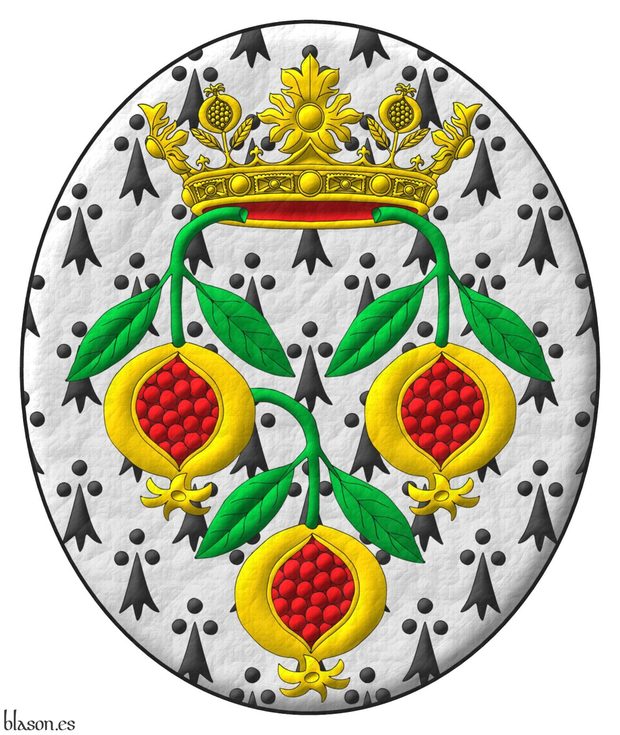
Ermine, three pomegranates inverted Or, seeded Gules, slipped and leaved Vert, ensigned with an open crown, alternating four rosettes of acanthus leaves, visible three, and four pomegranates Or, visible two, lined Gules.
Escudo de armiños, tres granadas ranversadas de oro, rajada de gules, talladas y hojadas de sinople, sumadas de una corona abierta, alternando cuatro rosetas de hojas de acanto, visibles tres, y cuatro granadas, visibles dos, todas de oro, forrada de gules.
Coat of arms emblazoned by me with an oval shape, illuminated, and with a leather finishing that seems watercolor.
Blazon keywords: Without divisions, Ermine, Three, Pomegranate, Reversed, Or, Seeded (pomegranate), Gules, Slipped, Leaved, Vert, On, One, Crown, Alternately, Four, Rosette of acanthus leaves, Visible, Two and Lined.
Style keywords: Outlined in sable, Oval, Illuminated and Leather.
Classification: Socioeconomic, Interpreted and Coat of arms.
Bearer: Granada, Soberana y Muy Noble Orden de la.


James I of Aragon
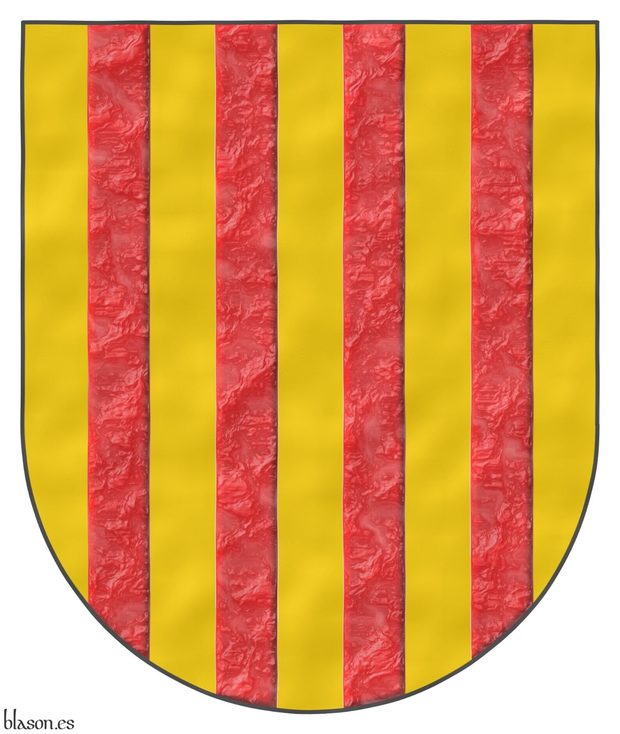
King of Aragon, Valencia and Majorca, Count of Barcelona, Count of Urgell, Lord of Montpellier and known as the Conqueror
Or, four pallets Gules.
Escudo de oro, cuatro palos de gules.
Coat of arms interpreted by me as follows: the escutcheon shape is semicircular; the field is rendered in flat Or with a watercolored effect; and the pallets are illuminated and finished with a crystalline texture.
A semicircular-shaped shield of Aragon can be seen, for instance, in [Argote de Molina, G.; 1588; chapter XLII].
This shield, but with a pointed base, appears in the second part of the armorial [Wijnbergen; 1265; shield no. 1,293], under the title «Le roy Darragon». This second part was compiled between 1270 and 1285 and, since James I was king of Aragon from 1213 to 1276, it could refer to him; although it might also refer to his son Peter III, the Great, who succeeded James I in 1276.
This coat of arms is also the arms of Aix-en-Provence, granted to that French city, according to tradition, by Alfonso II of Aragon [Aix-en-Provence; 1351], grandfather of James I, the Conqueror.
Blazon keywords: Without divisions, Or, Four, Pale and Gules.
Style keywords: Semi-circular, Illuminated, Watercolor and Crystalline.
Classification: Interpreted, Personal, Coat of arms and Kingdom of Aragon.
Bearer: James I of Aragon.


Jesus Christ, with bezants Or
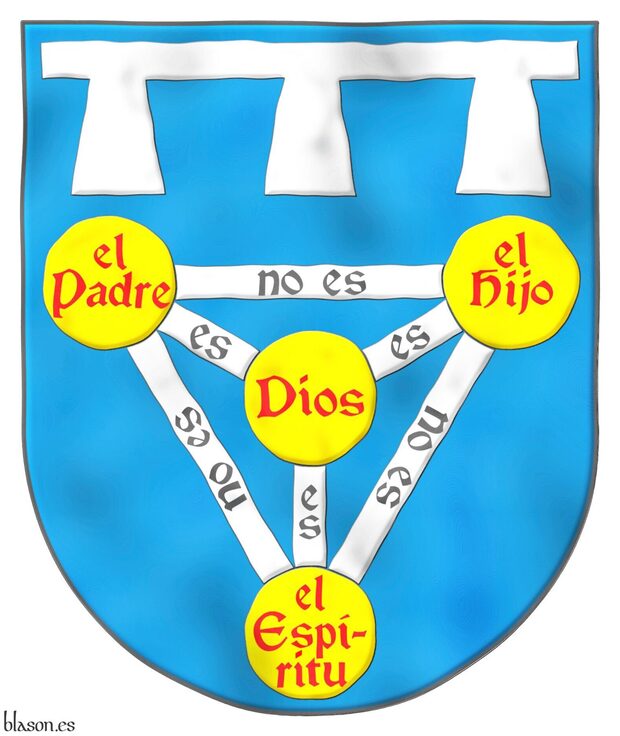
Azure, a pall couped Argent, its three arms charged with «es» Sable, within a triangle reversed Argent, its three arms charged with «no es» Sable, all debruised by four bezants, three on the vertex of the triangle, in dexter chief, charged with «el Padre», in sinister chief, charged with «el Hijo», in base, charged with «el Espítiru», and one on the fess point, charged with «Dios» Gules; in chief a label of three points Argent.
Escudo de azur, una perla recortada de plata, sus tres brazos cargados con «es» de sable, dentro de un triángulo ranversado de plata, sus tres brazos cargados con «no es» de sable, todo resaltado de cuatro bezantes de oro, tres sobre los vértices del triángulo, en la diestra del jefe, cargado de «el Padre», en la siniestra del jefe, cargado con «el Hijo», en la punta, cargado con «el Espítiru» y uno sobre el corazón, cargado con «Dios» todo de gules; en jefe un lambel de tres pendientes de plata.
Imaginary coat of arms that I have interpreted as follows: its base is semicircular (round); its field is illuminated in Azure; the rest is illuminated in Argent and outlined in Sable, except for the bezants which are Or and also outlined in Sable; its letters in plain tinctures, some Gules and others Sable; and the set with a glazed finish.
Pall
The pall (perla) as defined by [Avilés, J.; 1780a; page 239] is «a figure composed of three moving cotises, or that emerge from the two angles of the Chief and the Base, which meet in the center or heart of the Shield in the form of a Greek Y, as if this figure were formed from a half Saltire, and a half Pale».
Blazon keywords: Without divisions, Azure, One, Pall, Couped, Argent, Three, Charged, Letter, Sable, Within, Triangle, Reversed, Four, Bezant, In the dexter chief, In the sinister chief, In base, In the fess point, Gules, Cadency and Label of three points.
Style keywords: Semi-circular, Illuminated, Outlined in sable and Glass.
Classification: Religious, Interpreted, Imaginary and Coat of arms.
Imaginary bearer: Jesus Christ.


Jose Manuel Gutiérrez Benítez
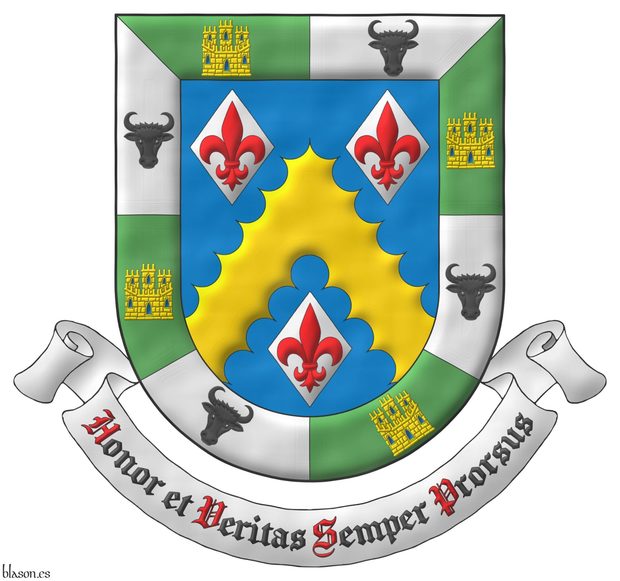
Azure, a chevron engrailed Or between three lozenges Argent, each charged with a fleur de lis Gules; a bordure compony of eight sections, four Vert each charged with a castle triple-towered Or, port and windows Azure, masoned Sable, and four Argent each charged with a bull's head caboshed Sable. Motto: «Honor et Veritas Semper Prorsus» Sable, with initial letters Gules, over a scroll Argent.
Escudo de azur, un cabrio angrelado de oro acompañado de tres losanges de plata, cada uno cargado de una flor de lis de gules; una bordura componada de ocho compones, cuatro de sinople, cargados cada uno de un castillo de oro, aclarado de azur, mazonado de sable, y cuatro de plata, cargados cada uno de un rencuentro de toro de sable. Lema: «Honor et Veritas Semper Prorsus» de sable, con letras iniciales de gules, sobre una filacteria de plata.
Arms designed by me, illuminated with lights and shadows, contoured in Sable, with a semi-circular outer contour and with a watercolor finish.
Design rationale
In Spanish heraldry, the use of bordures is often a matter of personal preference, in this case, the tinctures and charges on this bordure compony are a proud emblem of the bearer's origins from Utrera, Seville, the white represents the local architecture, the green symbolizes the olive groves, and the bull's head denotes Utrera as the cradle of the brave bull, a reference, along with the castle, to the arms of his town. The Latin motto tells us, «Honor and Truth Always at the Forefront».
Blazon keywords: Azure, Or, Argent, Gules, Vert, Sable, One, Three, Four, Eight, Chevron, Engrailed, Lozenge, Fleur de lis, Bordure, Compony, Castle, Triple-towered, Port and windows, Masoned, Bull, Head, Caboshed and Motto.
Style keywords: Outlined in sable, Illuminated, Semi-circular and Watercolor.
Classification: Personal, Created, Design rationale, Boa and Coat of arms.
Bearer: Gutiérrez Benítez, Jose Manuel.


Kathleen Kane

Argent, four leaves of silver-leaved whitebeam (Sorbus Aria Lutescens) in saltire, stems interlaced Vert, on a chief Gules, three crosses of Saint Brigid Argent.
Escudo de plata, cuatro hojas de serbal blanco (Sorbus Aria Lutescens) en sotuer, los tallos entrelazados de sinople, en un jefe de gules, tres cruces de santa Brígida de plata.
Blazon keywords: Argent, Four, Leaf, In saltire, Stem, Interlaced, Vert, Chief, Gules, Three, Cross of Saint Brigid and Cross couped.
Style keywords: Outlined in sable, Rounded and Plain tincture.
Classification: Personal, Interpreted and Coat of arms.
Bearer: Kane, Kathleen.


Kingdom of Jerusalem

Metal Or over metal Argent.
Argent, a cross potent cantoned of four crosslets potent Or.
Escudo de plata, una cruz potenzada cantonada de cuatro cruces potenzadas todas de oro.
Illuminated with lights and shadows and with a freehand finish.
Perhaps the most classic example of non-compliance with the heraldic rule of tinctures having metal Or over metal Argent. In [Galdiano L.; Century XVII; folio 6], you can see a version of the arms of Jerusalem with the field in Gules, which would indeed follow the rule of tinctures as it is metal on color.
Blazon keywords: Without divisions, Argent, One, Cross potent, Cross couped, Cantoned, Four and Or.
Style keywords: Freehand, Outlined in sable, Illuminated, Semi-circular and Metal on metal.
Classification: Interpreted and Civic.
Bearer: Kingdom of Jerusalem.


Marc Eschenlauer
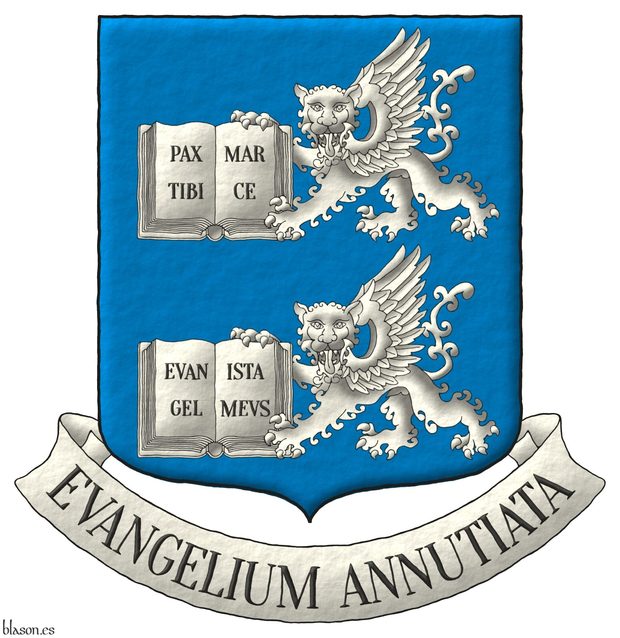
Azure, two lions passant, guardant, winged, each holding in its paws an open book Argent, with the inscription «Pax Tibi Marce Evangelista Meus» Sable distributed on their four pages. Motto: «Evangelium Annutiata».
Escudo de azur, dos leopardos alados, teniendo cada uno en sus garras un libro abierto todo de plata, con la inscripción «Pax Tibi Marce Evangelista Meus» de sable distribuida en sus cuatro páginas. Lema: «Evangelium Annutiata».
Coat of arms designed by me, illuminated with lights and shadows, contoured in Sable, with an ogee outer contour and with a freehand finishing.
Blazon keywords: Azure, Argent, Sable, Two, One, Four, Leopard, Winged, Grasping, Paw, Closed book, Book, Inscribed, Page and Motto.
Style keywords: Outlined in sable, Illuminated, Ogee and Freehand.
Classification: Religious, Created, Boa and Coat of arms.
Bearer: Eschenlauer, Marc.


Municipality of Gudja

Argent, a fess dancetty of four points Gules. Motto: «Pluribus Parens».
Escudo de plata, una faja encajada de cuatro piezas de gules. Lema: «Pluribus Parens».
Arms emblazoned by me, illuminated with lights and shadows, contoured in Sable, with a pointed external shape and with a freehand finishing.
G0138, Chief Herald of Arms of Malta's grant for the arms of the municipality of Gudja, Malta. These arms have been emblazoned by me for such grant. The motto «Pluribus Parens» means «mother of many children», as Gudja was the historical center and origin of several nearby settlements such as Safi, Kirkop, Luqa, Mqabba, Tarxien, and others.
Blazon keywords: Argent, Gules, Four, Fess, Dancetty and Motto.
Style keywords: Outlined in sable, Illuminated, Pointed and Freehand.
Classification: Civic, Interpreted, Boa and Coat of arms.
Bearer: Gudja, municipality of.


![Ver [Pedro IV de Aragón; 1353] en referencias bibliográficas. Libro abierto, hojas de plata, filo de oro, guardas de gules, tapas de sable.](../css/Libro.Bibliografia.png)
Pedro IV de Aragón; 1353

Pedro IV of Aragon, also known as Pedro III of Aragon as he himself called, «Ordinance made by the very high and excellent Prince and Lord Lord Don Pedro the third King of Aragon, on the manner in which the Kings of Aragon will be consecrated and they themselves will be crowned», in the Royal Aragonese Chancery, 1353.
Bibliographical reference of century XIV.
The author is Pedro IV de Aragón.
The following article cites this bibliographic reference:
External resource:


Peter IV of Aragon

And II of Valencia and of Ampurias, I of Mallorca and Sardinia, and III of Barcelona.
Or, four pallets Gules.
Escudo de oro, cuatro palos de gules.
Coat of arms of this king of Aragon interpreted by me as follows: the escutcheon shape is curved triangular; the field and the 4 pallets are rendered in flat tinctures Or and Gules; and the whole shield has a watercolored finish.
This curved triangular shape of the escutcheon is inspired by the shield shown in the lower central part of a document issued by the king himself [Pedro IV de Aragón; 1353].
Blazon keywords: Without divisions, Or, Four, Pale and Gules.
Style keywords: Triangular curved, Illuminated and Watercolor.
Classification: Interpreted, Personal, Coat of arms and Kingdom of Aragon.
Bearer: Peter IV of Aragon.


Pixiv
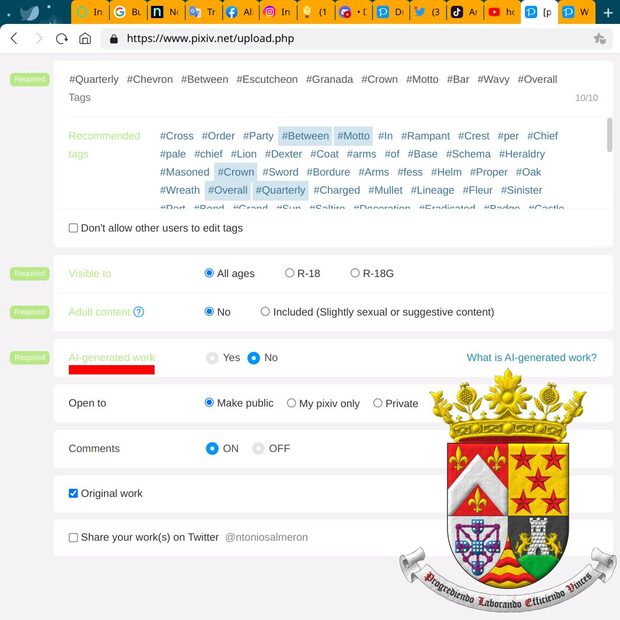
My heraldic Pixiv wall is Dr.A.Salmeron @antoniosheraldry and pixiv.me/antoniosheraldry.
Pixiv is a Japanese online community for artists. I post in Pixiv 2 or 3 coats of arms per week. They use a strict form to post with many mandatory input fields. This week, they have added a new mandatory field «AI-generated work: Yes / No», AI ~ Artificial Intelligence. In the image, I have highlighted this new field in red.
Categories: Technology, Social networks, Quarterly, Gules, One, Chevron, Argent, Between, Three, Fleur de lis, Or, Five, Mullet, In saltire, Four, Escutcheon, In cross, Azure, Charged, Nine, Bezant and plate, Two, Flank, Fesswise, Center, Overall, Carbuncle, Cord, In orle, Knotted, Purpure, Overall (all), Sable, Mount, Issuant from base, Vert, On, Tower, Port and windows, Masoned, Wolf, Supporting, Enté en point, Fess, Wavy, Crown of the Sovereign and Most Noble Order of the Pomegranate, Crown and Motto.


Ramon Berenguer IV, Count of Barcelona

Or, four pallets Gules.
Escudo de oro, cuatro palos de gules.
Coat of arms of the Count of Barcelona interpreted by me with the following features: the escutcheon shape is semicircular; the field is rendered in flat Or; the pallets are illuminated; and the whole has been given a heavily beaten metal finish.
[Menéndez Pidal de Navascués, F.; 1988; page 537] tells us that, unlike other more territorial emblems, «from his earliest seal the pallets appear on the shield of the equestrian figures on both sides, and in line with this configuration the emblem is inherited, without distinction, by his three sons and all his grandsons... it seems one must conclude that the emblem had a familial, not territorial, character from the very beginning».
Blazon keywords: Without divisions, Or, Four, Pale and Gules.
Style keywords: Semi-circular, Illuminated and Hard metal.
Classification: Interpreted, Personal, Coat of arms and County of Barcelona.
Bearer: Ramon Berenguer IV, Count of Barcelona.


Reverend Nilda Ernestina Lucca de Anaya
Azure, a chevron Or, between in chief a cross potent cantoned of crosslets, and a lion rampant, and in base a Celtic Trinity knot Argent. Crest: A galero Sable, with two cords, each with one tassel Gules and Sable.
Credits: Ernesto Juan Anaya is the designer of the coat of arms and Antonio Salmerón y Cabañas is the author of the heraldic art.
Blazon keywords: Azure, One, Chevron, Or, Between, In chief, Cross of Jerusalem, Cross couped, Cross potent, Cantoned, Four, Crosslet, Lion, Rampant, In base, Celtic Trinity knot, Knot, Celtic, Trinity, Crest and mantling, Galero, Cord and Tassel.
Style keywords: Outlined in sable, Illuminated, Pointed and Freehand.
Classification: Religious, Interpreted and Coat of arms.
Bearer: Lucca de Anaya, Nilda Ernestina.


Spain, Kingdom of
![Spain, Kingdom of Quarterly: 1 Gules, a castle triple-towered Or, port and windows Azure, masoned Sable [for Castile]; 2 Argent, a lion rampant Purpure, armed and langued Gules, crowned Or [for Leon]; 3 Or, four pallets Gules [for Aragon]; 4 Gules, a chain orlewise, crosswise, and saltirewise Or, charged in the fess point with an emerald Vert [for Navarre]; enté en point Argent, a pomegranate proper, seeded Gules, slipped and leaved Vert [for Granada]; an inescutcheon Azure, three fleurs de lis Or, 2 and 1, a bordure Gules [for Bourbon].](../escudo_armas/EspanaR.21.Escudo.TrazoAlzado.jpg)
Quarterly: 1 Gules, a castle triple-towered Or, port and windows Azure, masoned Sable [for Castile]; 2 Argent, a lion rampant Purpure, armed and langued Gules, crowned Or [for Leon]; 3 Or, four pallets Gules [for Aragon]; 4 Gules, a chain orlewise, crosswise, and saltirewise Or, charged in the fess point with an emerald Vert [for Navarre]; enté en point Argent, a pomegranate proper, seeded Gules, slipped and leaved Vert [for Granada]; an inescutcheon Azure, three fleurs de lis Or, 2 and 1, a bordure Gules [for Bourbon].
Escudo cuartelado: 1o de gules, un castillo de oro, aclarado de azur, mazonado de sable [de Castilla]; 2o de plata, un león rampante de púrpura, lampasado y armado de gules, coronado de oro [de León]; 3o de oro, con cuatro palos de gules [de Aragón]; 4o de gules, una cadena puesta en orla, en cruz y en sotuer de oro, cargada en el centro de una esmeralda de sinople [de Navarra]; entado en punta de plata, una granada al natural, tajada de gules, tallada y hojada de sinople [de Granada]; un escusón de azur, tres flores de lis de oro, 2 y 1, una bordura de gules [de Borbón].
Coat of arms painted by me, illuminated with lights and shadows, contoured in Sable, with a semi-circular external shape and with a freehand finishing.
Arms of the Kingdom of Spain emblazoned by me. Although in the official blazon text it is blazoned as a point vert, and as a point what is painted in a way that it is not known whether it is a large point or an uncutt circular emerald, in the blazon I have described it as an emerald both in Spanish and in English, since the point does not have a clear heraldic existence in Spanish and even less so in English.
Blazon keywords: Gules, Azure, Purpure, Vert, Or, Argent, One, Three, Four, Quarterly, Castle, Triple-towered, Port and windows, Masoned, Lion, Rampant, Crowned, Pallet, Chain, Orlewise, Crosswise, Saltirewise, Charged, In the fess point, Emerald, Enté en point, Pomegranate, Proper, Slipped, Leaved, Inescutcheon, Fleur de lis, Ordered and Bordure.
Style keywords: Outlined in sable, Illuminated, Semi-circular and Freehand.
Classification: Civic, Kingdom of Spain, Interpreted, Boa and Coat of arms.
Bearer: Spain, Kingdom of.


Thanks to the Ordo Equestris Reginae Caeli
I thank the Ordo Equestris Reginae Caeli, oerc.eu, for appointing me correspondent Eques H. C., it is an honor for me. Special thanks to David Perez Alvarez.
Blazon keywords: Order, Decoration, Azure, Or, Argent, One, Four, Eight-pointed cross, Cross couped, Fleur de lis, Crowned and Monogram.
Style keywords: Outlined in sable, Illuminated and Semi-circular.
Classification: Interpreted, Boa, Certification and Heraldic document.
Bearer: Ordo Equestris Reginae Caeli.


Vidriales, C. M.

Interpreted coat of arms: with a semi-circular shape; illuminated with metals argent and or and colors sable and azure; outlined with sable; and a freehand finish.
Blazon keywords: Party per pale, Argent, Cross, Sable, Bordure, Motto, Or, Thirteen, Hurt, Hurt, torteau, pellet, pomme and golpe, Azure, Three, In pale, Four, Five, Chief, Fleur de lis, Label and Suspended.
Style keywords: Freehand, Semi-circular, Illuminated and Outlined in sable.
Classification: Coat of arms, Interpreted and Personal.
Bearer: Vidriales, C. M..


Vidriales, M. P.

Interpreted coat of arms: with a semi-circular shape; illuminated with metals argent and or and colors sable and azure; outlined with sable; and a freehand finish.
Blazon keywords: Party per pale, Argent, Cross, Sable, Bordure, Motto, Or, Thirteen, Hurt, Hurt, torteau, pellet, pomme and golpe, Azure, Three, In pale, Four, Five, Chief, Fleur de lis, Cantoned and Martlet.
Style keywords: Freehand, Semi-circular, Illuminated and Outlined in sable.
Classification: Coat of arms, Interpreted and Personal.
Bearer: Vidriales, M. P..
-
Language
-
Categories of heraldry
-
Divisions of the field
- Without divisions
- Party per pale
- Party per fess
- Party per bend
- Party per bend sinister
- Tierce
- Tierce sinister
- Tierced per pale
- Tierced per fess
- Tierced per bend
- Tierced pallwise inverted
- Quarterly
- Quarterly per saltire
- Gyronny
- Party per fess, the chief per pale
- Party per pale, the sinister per fess
- Party per fess, the base per pale
- Party per pale, the dexter per fess
- Chapé
- Chaussé
- Embrassé
- Contre-embrassé
- Party per chevron
- Enté
- Enté en point
- Flanched
-
Metals
-
Colours
-
Furs
-
Other tinctures
-
Ordinaries and sub-ordinaries
-
Diminutives of the ordinaries
-
Geometric charges
-
Composite ordinaries
-
Inanimate charges from Nature
Atom, Crescent, Diamond, Emerald, Estoile, Increscent, Lightning flash, Moon, Mount, Mullet, Mullet of four points, Orbital, Plough of Ursa Major, Rainbow, Ray of the sun, River, Sea, Snowflake, Sun, Sun in splendour, Sun of May, Trimount, Water and Wave.
-
Vegetal charges from Nature
Acorn, Apple, Apple tree, Ash, Bluebonnet, Camellia, Chrysanthemum, Cinquefoil, Cornflower, Dogwood flower, Double rose, Elm, Fleur de lis, Flower, Gourd, Holm oak, Hop cone, Kapok tree, Laurel, Lily, Linden, Lotus flower, Madonna lily, Mexican cedar tree, Oak, Olive tree, Palm tree, Plantain plant, Pomegranate, Poplar leaf, Rose, Shamrock, Sunflower, Thistle, Tree, Tulip, Vine and Wheat.
-
Animal charges from Nature
Badger, Bald eagle, Barbel, Barn owl, Bear, Beaver, Beetle, Bighorn sheep, Blackbird, Boar, Brach hound, Bull, Doe, Dog, Dolphin, Dove, Eagle, Elephant, Falcon, Female figure, Fish, Flame, Fly, Fox, Frog, Goat, Goldfinch, Goose, Heron, Horse, Hummingbird, Jaguar, Lark, Leopard, Lion, Lion passant, Lion rampant guardant, Lioness, Lynx, Male figure, Martlet, Merino ram, Owl, Panther, Parrot, Peacock, Pelican, Pelican in her piety, Puffin, Quetzal, Raven, Roe deer, Rooster, Savage, Seagull, Serpent, She-wolf, Stag, Starling, Talbot, Tyger, Vulture, Warren hound and Wolf.
-
Parts of natural charges
Arm, Beak, Branch, Caboshed, Chest, Claw, Covert, Dorsal fin, Eagle claw, Ermine spot, Escallop, Feather, Foot (palmiped), Foreleg, Forepaw, Hand, Head, Heart, Hoof, Leaf, Neck, Ostrich feather, Palm frond, Paw, Roe deers' attires, Shoulder, Sprig, Stags' attires, Stem, Swallow-tail, Tail, Tail addorsed, Tail fin, Talon, Tooth, Trunk, Trunk (elephant), Two hands clasped, Two wings in vol, Udder, Wheat spike, Wing and Wrist.
-
Artificial charges
Ace of spades, Anchor, Anvil, Arch, Arm vambraced, Armillary sphere, Arrow, Axe, Bell, Bell tower, Beret, Bonfire, Book, Bookmark, Bow, Branding iron, Bridge, Broken, Buckle, Cannon, Cannon dismounted, Cannon port, Canopy roof, Carbuncle, Castle, Celtic Trinity knot, Chain, Chess rooks, Church, Clarion, Clay pot, Closed book, Club, Column, Comb, Compass rose, Conductor's baton, Cord, Covered cup, Crozier, Crucible, Cuffed, Cup, Cyclamor, Dagger, Double vajra, Drum, Ecclesiastical cap, Fanon, Federschwert, Fleam, Four crescents joined millsailwise, Galician granary, Garb, Gauntlet, Geometric solid, Grenade, Halberd, Hammer, Harp, Host, Hourglass, Key, Key ward, Knight, Knot, Lantern, Letter, Line, Loincloth, Menorah, Millrind, Millstone, Millwheel, Monstrance, Mortar, Mullet of six points pierced, Nail, Non-classic artifact, Norman ship, Number, Oar, Oil lamp, Open book, Page, Pair of scales, Parchment, Pestle, Piano, Pilgrim's staff, Plough share, Polish winged hussar, Port, Portcullis, Potent, Quill, Ribbon, Rosette of acanthus leaves, Sabre, Sackbut, Sail, Scroll, Scythe, Sheaf of tobacco, Ship, Skirt, Spear, Spear's head, Stairway, Star of David, Step, Sword, Symbol, Tetrahedron, Torch, Tower, Trident, Trumpet, Turret, Two-handed sword, Wagon-wheel, Water-bouget, Wheel, Winnowing fan and With a turret.
-
Immaterial charges
Angel, Archangel, Basilisk, Dragon, Dragon's head, Garuda, Golden fleece, Griffin, Heart enflamed, Justice, Mermaid, Our Lady of Mercy, Ouroboros, Paschal lamb, Pegasus, Phoenix, Sacred Heart of Jesus, Saint George, Sea-griffin, Trinity, Triton, Unicorn, Winged hand and Wyvern.
-
External elements
-
Heraldic creations
-
References
-
Formats
-
Keywords on this page
Port and windows, Between, Proper, Pointed, Azure, Boa, Bordure, Charged, Castle, Crest, Five, Crown, Crowned, Created, Cross, Cross couped, Four, Triple-towered, Outlined in sable, Two, In the fess point, In base, Coat of arms, Fess, Fleur de lis, Personal, Pomegranate, Gules, Leaved, Illuminated, Interpreted, Chief, Motto, Lion, Masoned, Semi-circular, Or, Pale, Argent, Without divisions, Civic, Crosswise, Rampant, Sable, Vert, Slipped, Freehand, Three and One.

